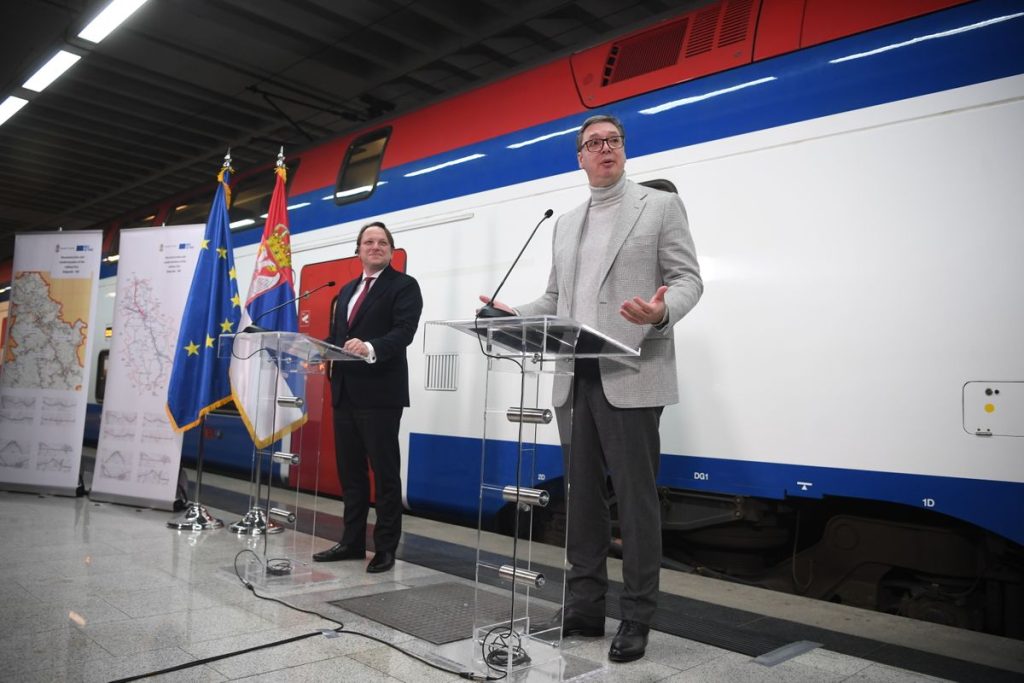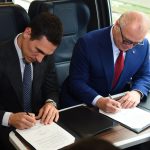 The European Commission will provide a EUR 600 million grant to support the modernisation Belgrade-Niš railway line, part of a EUR 2.2 billion financial package for the upgrade of the TEN-T Corridor X in Serbia.
The European Commission will provide a EUR 600 million grant to support the modernisation Belgrade-Niš railway line, part of a EUR 2.2 billion financial package for the upgrade of the TEN-T Corridor X in Serbia.
The announcement was made by the EU Commissioner for Neighbourhood and Enlargement, Olivér Várhelyi, during an official meeting with the Serbian President Aleksandar Vučić and Prime Minister Ana Brnabić.
During a train journey between Belgrade Central station and Ripanj, a suburb of the capital, the EIB Head of the Regional Representation for the Western Balkans, Alessandro Bragonzi, and the Minister of Transport and Infrastructure, Goran Vesić signed an agreement for the first tranche of the financing for the railway project.
Out of the grant, EUR 265 million has been already approved so far for the Belgrade – Niš railway line that will allow trains to run between the two cities with the speed of up to 200 km/h in around 100 minutes. The rest of the package consists of a EUR 1.1 billion loan from the EIB and a EUR 550 million EBRD loan. EUR 525 million will be covered by Serbia’s state budget.
The agreement, signed in the presence of the Serbian President, the EU Commissioner and the Minister of European Integration Tanja Miscevic, includes a grant in the total amount of EUR 598 million, as part of the financial package for railway Corridor 10. The financing will support the construction works for the Stalac – Djunis rail section of the third stage of the future high-speed railway designed for speeds of up to 200 km/h. The project concerns the construction of a 17.7 km double track from Stalać to
Djunis and the modernisation of the existing stations.
The Economic and Investment Plan (EIP) 2020-2022 flagship project includes the Stalać – Đunis section on the Belgrade – Niš railway line which received EUR 83.4 million grant from the Western Balkans Investment Framework (WBIF), with a previous EU grant of EUR 1.5 million. The works on this section are expected to be completed in 2026.
“When comes to railway transport, Serbia intends to be the best country in the region in the next ten years and we are trying to maintain the dynamics with the developed European countries. This grant for the modernisation of Belgrade-Niš railway line is a huge help from the EU to implement country’s largest infrastructure project,” the Serbian President said.
The Belgrade-Niš high-speed railway will be 230 km long, and the work is expected to be completed in 2029. The construction will take place in three stages, covering the Belgrade – Velika Plana, Velika Plana – Paracin and Paracin – Niš rail sections.
“The Belgrade-Niš line will be the backbone of the regional development. It will foster the growth of the local economy and will create additional jobs. It is the infrastructure that every investor needs. When deciding which country to choose, the first thing you look at is the connectivity, the second is a reliable source of energy, and the third is the workforce,” the Commissioner said.
The Corridor X runs between Salzburg in Austria and Thessaloniki in Greece and accounts for 872 km of track in Serbia, representing 23% of the entire railway network. It connects the country with Croatia, Hungary, Bulgaria and North Macedonia and further south with Greece.
The rail Corridor X is part of the Economic and Investment Plan (EIP) for the Western Balkans 2021-2027 that which will accelerate the regional integration of the region with the EU. The plan which covers 10 investment flagships will be financed by the EU with EUR 9 billion with a potential to mobilise EUR 30 billion in public and private investment. This plan identifies sustainable transport under three flagship priorities focusing on East-West (which includes Belgrade-Nis line) and North-South connectivity as well as the connections of the coastal regions. In 2020-2022 the EU contribution to fourteen projects had a value of EUR 1 billion in grants under the EIP, which should leverage EUR 1.4 billion in loans from WBIF partner financial organisations for over EUR 2.7 billion in investments in the region.
Share on:








